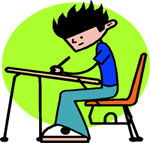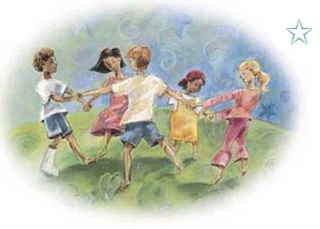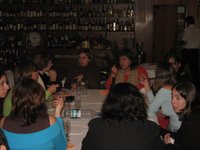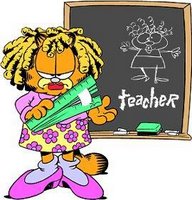
Friday, December 22, 2006
"Santa Claus Is Coming To Town"
You better watch out
You better not cry
You better not pout
I'm telling you why
Santa Claus is coming to town
He's making a list,
Checking it twice;
Gonna find out who's naughty or nice.
Santa Claus is coming to town.
He sees you when you're sleeping
He knows when you're awake
He knows if you've been bad or good
So be good for goodness sake
You better watch out
You better not cry
You better not pout
I'm telling you why
Santa Claus is coming to town
Sunday, December 03, 2006
Teacher's evaluation sheet
 Comportamento
ComportamentoRespeita os colegas, professoras e auxiliar de educação
Fala na sua vez
É organizado
Chega à aula a horas
Não falta às aulas sem a devida justificação
Faz os trabalhos
Colabora na arrumação da sala
Contribui para um bom ambiente na sala de aula
Atitudes
Demonstra interesse pela língua
Demonstra interesse pelos trabalhos realizados
Comunicação Oral
Compreensão:
Demonstra compreensão global da língua no seu contexto
Prevê e faz suposições
Segue instruções simples
Compreende a linguagem da aula
Produção:
Tem uma pronúncia adequada
Participa espontaneamente
Recorda vocabulário/expressões leccionadas
Utiliza a linguagem de sala de aula
Comunicação escrita
Compreensão:
Demonstra compreensão global da língua no seu contexto
Segue instruções simples
Relaciona a linguagem praticada oralmente com a forma escrita
Relaciona imagem com palavras ou frases
Produção:
Copia correctamente frases
Escreve (sem copiar) correctamente as palavras
Produz frases escritas seguindo um exemplo
Relaciona a linguagem praticada oralmente com a forma escrita
Saturday, December 02, 2006
Self-Evaluation Sheet

My name is: _________________________ Date: __/__/__
à frente de cada item estarão smiles que os alunos seleccionam
Comportamento
Respeito os meus colegas, professoras e auxiliar de educação
Falo na minha vez
Sou organizado
Chego à aula a horas
Não falto às aulas sem a devida justificação
Faço os trabalhos
Colaboro na arrumação da sala
Contribuo para um bom ambiente na sala de aula
Atitudes
Demonstro interesse pela língua
Demonstro interesse pelos trabalhos realizados
Conhecimentos ( Aqui colocam os temas que trataram!)
Já sei:
Dizer as cores
Contar (números)
Vocabulário sobre o Dia das Bruxas
Identificar as partes do corpo
Falar sobre a família
Vocabulário sobre o Natal
P.S. Esta ficha poderá também ser utilizado pelo professor para avaliar os alunos.
Que acham?
Thursday, November 09, 2006
seating students

a good idea to seat students wherever you want is:
give them a picture or a word and they have to seat in the chair with the correspondent pic.
It can be picture-picture or word-picture
Friday, October 20, 2006
To all teachers who have to deal with indiscipline...

Do rio que tudo arrasa se diz que é violento, mas ninguém diz violentas
as margens que o comprimem...
(Bertolt Brecht)
a great methaphor ;-)
Thursday, September 28, 2006
My checklist

My checklist to assess students has got the following items...
1. Social skills
Intellectual
Shows interest and enthusiasm
Seeks accuracy
Checks for understanding
Organised
Cooperative attitude
Positive about group work
Willing to help other
Contributes with ideas
Helps classmates
2. Work habits
Completes work on time
Uses time in class wisely
Checks work
Welcomes challenge
Is persistent
Accepts responsibility
Strives for quality work
Asks for help appropriately
Participates in class
Follows class/school rules
3. Skills
Speaking
Good pronunciation
Uses classroom language
Builds sentences
Repeats examples
Listening
Deduces meaning by context
Follows T’s instructions
Understands oral messages
Reading
Understands words
Understands sentences
Follows written instructions
Writing
Copies words correctly
Writes words correctly
Produces sentences following examples
Produces texts
The assessment should be formative in order to create motivation. It has to be a positive incentive. Evaluate must be a recognition of progress.
The assessment should be contextualised, natural and on a daily basis. it's not necessary to prepare specific instruments to evaluate. Teacher can use routines or the usual procedures to evaluate.(NO TESTS)
Teacher chooses 3/4 students per class and concentrates himself in those students.
Besides this checklist made by the teacher, students should also do their self evaluation.
Testing and assessment
I will always remember the horror of receiving my chemistry result when I was thirteen years old. I knew it wasn't going to be high, but to come bottom of the class was very upsetting. It was all made worse by the fact that the chemistry teacher read the results to the whole class, from first to last place. My humiliation was complete. Students can have very negative reactions towards tests and it's no surprise when they too may have had experiences like this.
Why testing doesn't workThere are many arguments against using tests as a form of assessment:
Some students become so nervous that they can't perform and don't give a true account of their knowledge or ability
Other students can do well with last minute cramming despite not having worked throughout the course
Once the test has finished, students can just forget all that they had learned
Students become focused on passing tests rather than learning to improve their language skills.
Reasons for testing
Testing is certainly not the only way to assess students, but there are many good reasons for including a test in your language course.
A test can give the teacher valuable information about where the students are in their learning and can affect what the teacher will cover next. They will help a teacher to decide if her teaching has been effective and help to highlight what needs to be reviewed. Testing can be as much an assessment of the teaching as the learning
Tests can give students a sense of accomplishment as well as information about what they know and what they need to review.
In the 1970's students in an intensive EFL program were taught in an unstructured conversation course. They complained that even though they had a lot of time to practise communicating, they felt as if they hadn't learned anything. Not long afterwards a testing system was introduced and helped to give them a sense of satisfaction that they were accomplishing things. Tests can be extremely motivating and give students a sense of progress. They can highlight areas for students to work on and tell them what has and hasn't been effective in their learning.
Tests can also have a positive effect in that they encourage students to review material covered on the course.
At university I experienced this first hand, I always learned the most before an exam. Tests can encourage students to consolidate and extend their knowledge.
Tests are also a learning opportunity after they have been taken. The feedback after a test can be invaluable in helping a student to understand something she couldn't do during the test. Thus the test is a review in itself.
Making testing more productive
Despite all of these strong arguments for testing, it is very important to bear in mind the negative aspects we looked at first and to try and minimise the effects.
Try to make the test a less intimidating experience by explaining to the students the purpose for the test and stress the positive effects it will have. Many may have very negative feelings left over from previous bad experiences.
Give the students plenty of notice and teach some revision classes beforehand.
Tell the students that you will take into account their work on the course as well as the test result.
Be sensitive when you hand out the results. I usually go through the answers fairly quickly, highlight any specific areas of difficulty and give the students their results on slips of paper.
Emphasise that an individual should compare their results with their own previous scores not with others in the class.
Learning from tests
Finally, it is very important to remember that tests also give teachers valuable information on how to improve the process of evaluation. Questions such as:
"Were the instructions clear?"
"Are the test results consistent with the work that the students have done on the course. Why/why not?"
"Did I manage to create a non-threatening atmosphere?"All of this will help the teacher to improve the evaluative process for next time.
Alternatives to testing
Using only tests as a basis for assessment has obvious drawbacks. They are 'one-off' events that do not necessarily give an entirely fair account of a student's proficiency. As we have already mentioned, some people are more suited to them than others. There are other alternatives that can be used instead of or alongside tests.
Continuous assessment
Teachers give grades for a number of assignments over a period of time. A final grade is decided on a combination of assignments.
Portfolio
A student collects a number of assignments and projects and presents them in a file. The file is then used as a basis for evaluation.
Self-assessment
The students evaluate themselves. The criteria must be carefully decided upon beforehand.
Teacher's assessment
The teacher gives an assessment of the learner for work done throughout the course including classroom contributions.
Conclusions
Overall, I think that all the above methods have strengths and limitations and that tests have an important function for both students and teachers. By trying to limit the negative effects of tests we can try to ensure that they are as effective as possible. I don't think that tests should be the only criteria for assessment, but that they are one of many tools that we can use. I feel that choosing a combination of methods of assessment is the fairest and most logical approach.
http://www.teachingenglish.org.uk/think/methodology/test.shtml
Monday, September 25, 2006
Listening, Speaking and Reading
Listening activities
1. Simon says
e.g. If you've got something green... put your hand up / stand on one leg / clap your hands/stamp your feet
2. Statues game
The children mime an activity to music and then stand still like statues when the music stops the last student to stop is out. ( Good for the 1st days' actitivities. Students can mime something they like. That's a way to know their likes)
3. Right or Wrong / True or False
Ask students to listen carefully. Explain you are going to tell them something. It might be right or wrong. If you're right they clap once if you're wrong theyclap twice.
e.g. Today's Monday?
Today's sunny?
This is Peter?
4. Colour Dictation
teacher gives a picture to each student. They have to listen to your instructions. You tell them what colour to use and what to colour.
5. Draw Dictation
Teacher describes a simple picture of a familiar scene with objects children know. Students listen and draw what you describe.
Afterwards you can choose 3/4 pictures the children have drwn and show them to the class. Ask students to spot the differennces.
Speaking Activities
- If your pupils cannot read yet they have to remember the word as a sound.
- If your pupils can read it is better if they first remember the sound of the word and then learn the spelling.
1. Finding pairs (pelmanism)
A memory game where children have to pick up two cards with the same picture or word. 8the cards are spread out face-down)
2. Shopping games
Children act the parts of shop assistants and customers in different kinds of shops to practise vocabulary.
e.g a pet shop. The shop assistant has got flashcards related to the theme and the customers have got money to go there are buy what they want,
3. Happy families (+/- Go fish)
Players in groups of three or four have to collet four cards from each other from the ame family or topic.
4. I spy...
It can be used with sounds / flashcards... You say I spy ...and students have to guess
e.g. i spy something beginning with the sound [sh]
5. Pass the ball
You need a tape recorder, a cd and a ball. Put on the music and the children keep passing the ball to the children next to them. When the music stops, the child with the ball has to answer a question.
Reading activities
- This is a big step because children have to understand the association between what they hear and what they read.
- learning to read in English is not as difficult if children can read in their own language.
1. Initial letter
Children recognise and collect the first letters of different words.
e.g. What letter does cat begin with?
2. Feel the letter
Children close their eyes and touch cut-out letter on a card. Find the "t" for tiger.
3. Clever parrot
The children have to repeat like a parrot. but they must be clever and only repeat teh word that's on the card the teacher is schowing.
Wednesday, September 20, 2006
Tuesday, September 19, 2006
Teachers' centre programmme-2006/2007 at International House

October 25th
Revisiting Classroom Management
Establishing routines and good learning habits right from the start.
November 22nd
Best Practice
Classroom ideas inspired by different approaches and methods from the experts with this age group
December 6th
Modelling language
Teachers are probably the best models for children. In this session, we will explore how to introduce language in a varied and meaningful way.
January 24th
The 'mobile' teacher
In this session, we will explore the concept of a portable portfolio of materials that busy teachers can carry around with them.
February 28th
Stories
Encouraging children to develop an interest in listening to, reading and writing stories
March 21st
Songs and rhymes
Ideas for ensuring that the use of these is varied and balanced
April 18th
Making Learning Memorable
Which principles and strategies can you use to make sure children remember the language they are exposed to?
May 2nd
Social Skills
When children are younger, we are not just teaching them language. What else is in the 'hidden curriculum' of the young learner classroom?
ADDRESS:
Rua Marquês Sá da Bandeira 161050-148 Lisboa
Telephones:
(00 351)213 151 493/4/6
Fax:
(00 351)213 530 081
Email addresses:
General: info@ihlisbon.com
Reception: recepcao@ihlisbon.com
Teacher Training: ttraining@ihlisbon.com pdenagy@ihlisbon.com
DoS: kathy.gordon@ihlisbon.com
ADoS: richard.fleming@ihlisbon.com
Monday, September 18, 2006
Routines/Classroom Management

- Control entry and exit of class
e.g. Give them a password to enter or leave the class;
Ask them questions;
Always line up
- Get visual attention at the beginning
e.g. a word puzzle on the BB
e.g. Ask specific Sts. to deliver the books, material, worksheet ; clean the board...
- Have a system to reward effort and behavior (perhaps u could make a competition between different classes)
e.g. Points scale (if the sts behave badly the T. takes out some points)
Bottle to fill with buttons(sts get buttons if they behave correctly)
- Write the Date/Weather and make it interactive(with the help of sts.)
- Attracting attention: To attract sts attention ( for instance to signal the end of an activity) use a musical instrument; put your hands up...
- Register: Sts should always answer in English (e.g. I'm here)
After some time T can ask a student to tell him who is absent/missing
- Speak English
It is very easy to use your mother tongue when asking children to do things. It's easier and quicker. But our aim is to teach English. So use it as often as possible. Use gestures to help u.
Sunday, September 17, 2006
Thursday, September 14, 2006
The challenge of teaching children

in. The challenge of teaching children by Carol Read.
Wednesday, September 13, 2006
Site
(Programa de Generalização de Inglês no âmbito do Programa de Enriquecimento Curricular)
Tuesday, September 12, 2006
Getting to know you games

Some more ideas...
1. Students listen, sing and gesture a song (e.g. Row, row your boat or The wheels on the bus). After that they draw a boat / bus in a poster and put windows where they glue these photos or draw their pictures.
2. Students draw their hands in a piece of paper, cut it out, write their name and decorate it. After that they glue their hands in a big poster.
3. Students write their names in a post-it and put it in a box. A student pick a paper from the box and the teacher blindfolds him, who has to find where that person is by asking the question "what's your name?". ( It's similar to the cabra-cega) If he founds him, the students tags his name in his clothes.
4. Students write their name in a piece of paper and a word that begins with the same letter in the back of the paper. After that, they present their works and put their names in their tables in front of them.
5. Memory Game
A students says his name. The next one has to say his own name and the previous ones.
eg. My name is .... His/her name is...
Saturday, September 09, 2006
Interesting articles: useful tips

Managing young learnersGail Ellis, Teaching Centre Manager, Paris and Janet Leclere , Teacher, Young Learners Centre, Paris
Teaching young learners requires a knowledge of the developmental differences between children and teenagers and of the appropriate management skills. This article concerns the personal observations and experiences of a teacher who moved from teaching teenagers to teaching young learners. It includes ideas for classroom management and teaching strategies.
Inside and outside the young learners classroom
The young learners market continues to grow amidst a decade of changing attitudes towards this sector of teaching. The teacher is now viewed as a highly-skilled professional who has the knowledge, skills, flexibility and sensitivities of a teacher both of children and of language, and one who is able to balance and combine the two successfully.The term 'young learners' in the network covers a wide age range; 4-18 years of age, and most problems encountered by teachers are due to a lack of understanding of the developmental differences between children and teenagers, and of the appropriate classroom management skills to deal with these. Differences include conceptual and cognitive variations, variations in attention spans and motor skills such as drawing and cutting, as well as social and emotional differences. An understanding of these differences can help develop the flexibility that teachers of young learners require.
New dimension
Janet Leclere joined the Paris Young Learners Centre last September, bringing with her valuable experience of teaching eight to ten-year-olds in French state primary schools. Her classes include a group of five-year-olds using Pebbles 1 (published by Longman); an age she had not taught before. 'Having been used to teaching older children, I found it difficult to accept that some children's attention would drift,' admitted Janet, who quickly realised that her classroom management skills needed to take on a new dimension to control and cater for the needs of these children.As it was not possible to observe classes at the centre, Janet took charge of her own self-development and arranged this at a local nursery school. These are her observations, which we hope will provide the starting point for further reflection and discussion in your own centres.
Classroom management and discipline
When children arrive, they put their coats on pegs, bags on the floor at their table places and then join you round the board. Only books and pencil cases on the tables. Avoid clutter - very young learner classrooms need to be very organised.Use two areas of the classroom.
For presentation of new language, practice activities using individual children, storytelling and opening and closing of lesson, the teacher sits on a stool next to the board and half-faces the children. Children should sit on the floor at their teacher's feet, with a further row of children behind on chairs to form a closed circle. This avoids sitting on the floor and makes you feel more in charge.
For activities, three or four children should sit at each table. Colour-code the tables. When children move from the board to the tables, get them to move group by group, not all at once. Children keep to the same places.Expect children to do what they are told, but be nice to them - even when you are feeling impatient.
Using the board
Present new language at the board. Use lots of flashcards. Involve all pupils - ask individuals to perform a small task: pointing to something, choosing a picture or sticking it on the board.
Children like to be picked, so make it fair. Ask the whole class a question, get them to repeat or drill.
Explain and demonstrate tasks you want children to do at the tables at the board. If using a worksheet, stick it on the board and demonstrate.
Routines and activities
Establish routines: always sit round the board to begin, play a game touching heads when taking the register, sing 'hello' to characters or sing a song they know. Everyone starts the lesson feeling confident and attentive.
Surprise activities can help to settle a class if the children become too excited. Try a series of movements in sequence e.g. touch your head three times, then shoulders, then knees. Vary the count and see if they can follow.
When changing activity, try using a rattle (e.g. rice in a box) rather than raising your voice to attract attention. This becomes a signal that children recognise. Start the activity, even if not all children are attentive. They will eventually join in with the others.
Work
Be aware of what sort of work children are doing at school. The teacher I observed worked on the skills of matching, comparing and classifying. These are all things we can develop and adapt.When children are working at tables let them finish as much as possible. Fast finishers can do another drawing, or colour in. As children finish, write on their worksheets to explain what they have drawn, stuck or classified etc. questioning them at the same time.
Starting primaryGail Ellis, Head of the Young Learners Centre, British Council, Paris and Special Lecturer in the School of Education, University of Nottingham
Teaching at primary level can cause many teachers, particularly those who have trained to teach adults, a variety of problems and generate a range of worries. Unfortunately, it is common for teachers to be asked by their institution to teach young learners even though they don't have specific training. Those first lessons with the class, which are quite probably in a different institution to your regular work, can seem daunting. In this article I provide some advice on how to deal with starting work with primary level students and I give ten top classroom management tips.
Before you begin to teach
Find out who your pupils are
Talk to the class teacher and find out if the children are complete beginners in English or have already learnt a little.
Are there any bilingual children in the class? If so, use them as your helpers.
Do any of the children speak another language?
You will find that the children will be highly motivated and excited about learning a foreign language. Your main aim, is to maintain this initial motivation and sustain their curiosity and interest so that they develop a real desire to learn the language, even if you don't feel they are learning very fast.
You need to be realistic and so do the children about how much they can learn in the relatively short time you will spend with them.It is quite normal for children to take some time before they actually start producing much language as they will need time to familiarise themselves with you - very probably the first native speaker of English they have ever met - and assimilate the language before they feel ready and confident enough to produce any.Be patient and don't be afraid of repeating things again and again - children need and enjoy lots of opportunities to hear the language. Just remember to be natural.
Practicalities
Get to know the class teacher and how they can help you.
How many pupils in your class?
What can you and can you not do in the classroom, for example, move furniture around?
Will the class teacher stay with you during the English lesson.Find out about your school's etiquette?
How long are your lessons? 45 minutes, one hour?
Are you allowed to display children's work on the classroom walls?
Can you create an English corner?
What resources does the school have that you can use?
How many photocopies are you allowed to make?
Can you take the children into the playground?
Can you use a computer?
Top ten classroom management tips for successful teaching
Plan what you are going to do in advance step by step and have clear aims so you and your pupils know exactly where you are going throughout a lesson. This is the only way you will be able to control up to 30 children in one class - and they will be the first to know if you haven't prepared and respond by becoming disruptive.
Start your year by being firm and be consistent in your own actions and behaviour - children expect a disciplined, structured classroom environment and respond well to routines.
Check with the class teacher what is acceptable and unacceptable behaviour and make it clear to the pupils that you expect the same behaviour.
Learn your pupils' names and address them directly.
Be mobile and walk round the class.
Have a clear signal for stopping activities or when you want children to be quiet.
Get silence and wait for their full attention before you start speaking and give clear instructions or demonstrations.
Make sure children understand what they have to do.
Never, underestimate children's abilities or intelligence. They may have very limited English but they still have the same interests and aspirations as any other child of their age.
Keep them interested by providing stimulating content and meaningful activities.
Always ensure that children have some English 'to take away' with them at the end of a lesson. Children will feel proud and have a sense of achievement if they leave the classroom being able to ask, for example, a new question in English, say something about themselves, or sing a song. This means (see the first point above) that your aims will be clear to the children.
Avoid activities that over-excite - it is often difficult to return to a calm and controlled learning environment after a noisy game.
Avoid activities that require a lot of movement as you will find that there is often very little space in a classroom for this type of activity.
Also avoid activities that require a lot of cutting and pasting unless there is a clear linguistic outcome, as these can cut into valuable time, apart from creating a great deal of mess.
Make positive comments about the children's work and efforts and let them see that you value their work.Have additional material prepared to cope with faster and slower pupils' needs and don't let activities go on too long.
These articles were taken from:http://www.teachingenglish.org.uk/think/methodology.
this site has lots of useful things...
Thursday, September 07, 2006
We are playing

When u have a few extra time just play a game...
1. ABC Bingo
Ask students to write two words in English (you can choose a topic) - e.g. BLUE / PINK.
Have a set of ABC in a bag. Take one letter. The students who have it can cross of this letter. The first one to finish the words wins.
2. Jumbled Words
Write some jumbled words on the board. Students have to guess the words.
e.g. OSOCHL = SCHOOL
3. Bomb Number
Take a number from a bowl and then pass a ball/balloon while the students count. When they reach the number you've taken, the student who has the ball loses.
4. Spell the word
Ask your class to sit in groups. Give each group a cardboard with mini post-its stuck inside. Each of the post-its should have letters of the alphabet written on. (make sure that there are sufficient of the most commonly used letters). Dictate some familiar words to your class while they race to spell the word with their post-its letters. The group that spells the word correctly first wins.
5. Who is it?
Cover a picture of a famous person with numbered post-its. Divide the class into groups and ask them to choose a number in turn. each number has a corresponding question. If they answer correctly, remove the post-it and the group can have one guess to identify the mystery person. Continue until one group gives the correct answer. (If they get the answer wrong you can cover the picture again).
...

I'll give you some more tips another day...I'm waiting for your ideas. Just comment or send them in an e-mail to me and then I post them in the blog.
Friday, September 01, 2006
What to do on the first class??

Some ideas to meet the new pupils...
1. My favourite Things
Talk with your class about their favourite things. You may ask the children to do a picture of either activities they like doing or favourite toys, games, books, etc. You may even bring pictures of your favourite things to class and show them to your students. After that , have them sit in a circle on the floor and ask them to show the picture to their friends. They may practise. "This is me. I like ..." Hang the pictures around.
2. Hide and Guess
Have your students sit in a circle. Pick one to go outside the room . Hide another student under a blanket in the middle of the circle. Have the first student come back to the classroom and guess who is under the blanket.
3. Memory Chain
Each student says his/her name and makes a gesture for something he/she likes to do. The next student has to repeat what the previous said and say his own name/gesture.
4. Hot Potato
you need a soft ball and a bomb clock. A student says "Hello. My name is..." and passes the ball to the next student and so on until times up. The student with the ball and who is speaking has to sit.
5. Blindfold
Blindfold a student and he/she has to guess the name of another student only by touch.
6. Guess who
Teacher gives clues about somebody and students have to guess who he/she is.
7. Name Recognition: The envelope game.
Write each child's name on an envelope using capital letters. Cut the letters for each child's name and put the letters inside the envelope. Distribute the envelopes and ask students to put the letters in the correct order to form names. When they finish they have to deliver the envelope to the right student.
8. Hello Game
All the children sit on chairs in a circle. The teacher is in the middle and goes up to a child, shake hands and say "Hello, my name is ....". The others students also stand up and introduce themselves to other students. When all the children are up and moving about the Teacher makes a noise with a drum or a whistle. The children must run and find a seat. There will be on seat too few.
9. Moving chairs
After a brief introduction ask student to arrange themselves alphabetically according to the first name.
10. Messages in Bottles
Let students prepare drawings/short messages about their favourites. Ask them to put their messages in plastic bottles. Then each child pick up a bottle and has to guess to whom this bottle belongs to.
Thursday, August 31, 2006
Na idade dos porquês - A portuguese poem to all teachers

Professor diz-me porquê?
Por que voa o papagaio
que solto no ar
que vejo voar
tão alto no vento
que o meu pensamento
não pode alcançar?
Professor diz-me porquê?
Por que roda o meu pião?
Ele não tem nenhuma roda
E roda gira rodopia
e cai morto no chão...
Tenho nove anos professor
e há tanto mistério à minha roda
que eu queria desvendar!
Por que é que o céu é azul?
Por que é que marulha o mar?
Porquê?
Tanto porquê que eu queria saber!
E tu que não me queres responder!
Tu falas falas professor
daquilo que te interessa
e que a mim não interessa.
Tu obrigas-me a ouvir
quando eu quero falar.
Obrigas-me a dizer
quando eu quero escutar.
Se eu vou a descobrir
Fazes-me decorar.
É a luta professor
a luta em vez de amor.
Eu sou uma criança.
Tu és mais alto
mais forte
mais poderoso.
E a minha lança
quebra-se de encontro à tua muralha.
Mas
enquanto a tua voz zangada ralha
tu sabes professor
eu fecho-me por dentro
faço uma cara resignada
e finjo
finjo que não penso em nada.
Mas penso.
Penso em como era engraçada
aquela rã
que esta manhã ouvi coaxar.
Que graça que tinha
aquela andorinha
que ontem à tarde vi passar!...
E quando tu depois vens definir
o que são conjunções
e preposições...
quando me fazes repetir
que os corações
têm duas aurículas e dois ventrículos
e tantas
tanta mais definições...
o meu coração
o meu coração que não sei como é feito
nem quero saber
cresce
cresce dentro do peito
a querer saltar cá para fora
professor
a ver se tu assim compreenderias
e me farias
mais belos os dias.
Alice Gomes (1946)
Useful Sites

Useful sites:
Flashcards-
http://www.esljunction.com/esl-efl-flashcards/esl-tefl-efl-flashcards.html
http://www.mes-english.com/flashcards.html
http://www.eslhq.com/gallery/browseimages.php?c=508
Activities and useful Ideas-
http://www.the-bus-stop.net/links.html
http://www.preschooleducation.com/
http://www.kizclub.com/index.html
http://www.first-school.ws/
http://www.genkienglish.net/games.htm
http://www.onestopenglish.com/
http://www.dltk-teach.com/
http://www.learnenglish.org.uk/kids/
http://www.welcometoenglishandfun.com/
http://www.bry-backmanor.org/activitypages.html
http://www.activityvillage.co.uk
http://www.angles365.com/recursos/rec00.htm
Coloring pages-
http://www.kidscolorpages.com/coloringpages.htm
http://www.coloringbookfun.com/
http://coloring-page.net/
http://www.artistshelpingchildren.org/coloringprintouts.html
http://www.lil-fingers.com/coloring/color.html
http://www.abcteach.com/ (to have full access you have to be a member)
Crafts-
http://www.dltk-kids.com/
http://www.enchantedlearning.com/Home.html
Games-
http://www.geocities.com/Athens/Delphi/1979/games.html#index
Deus quer, o Homem sonha, a Obra nasce
Deus quer, o homem sonha, a obra nasce.
Fernando Pessoa
Fico à espera dos vossos posts. Don't be shy!!







